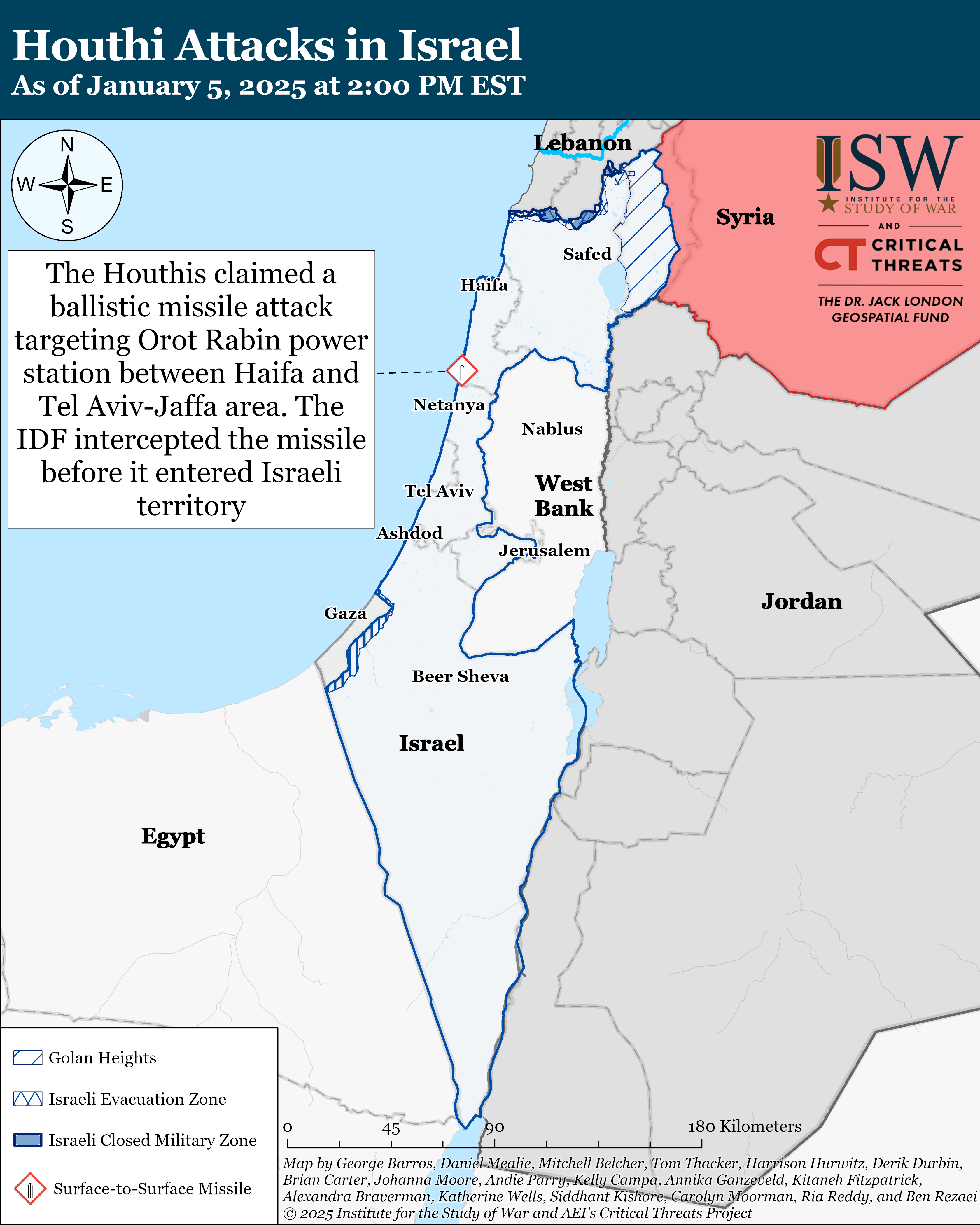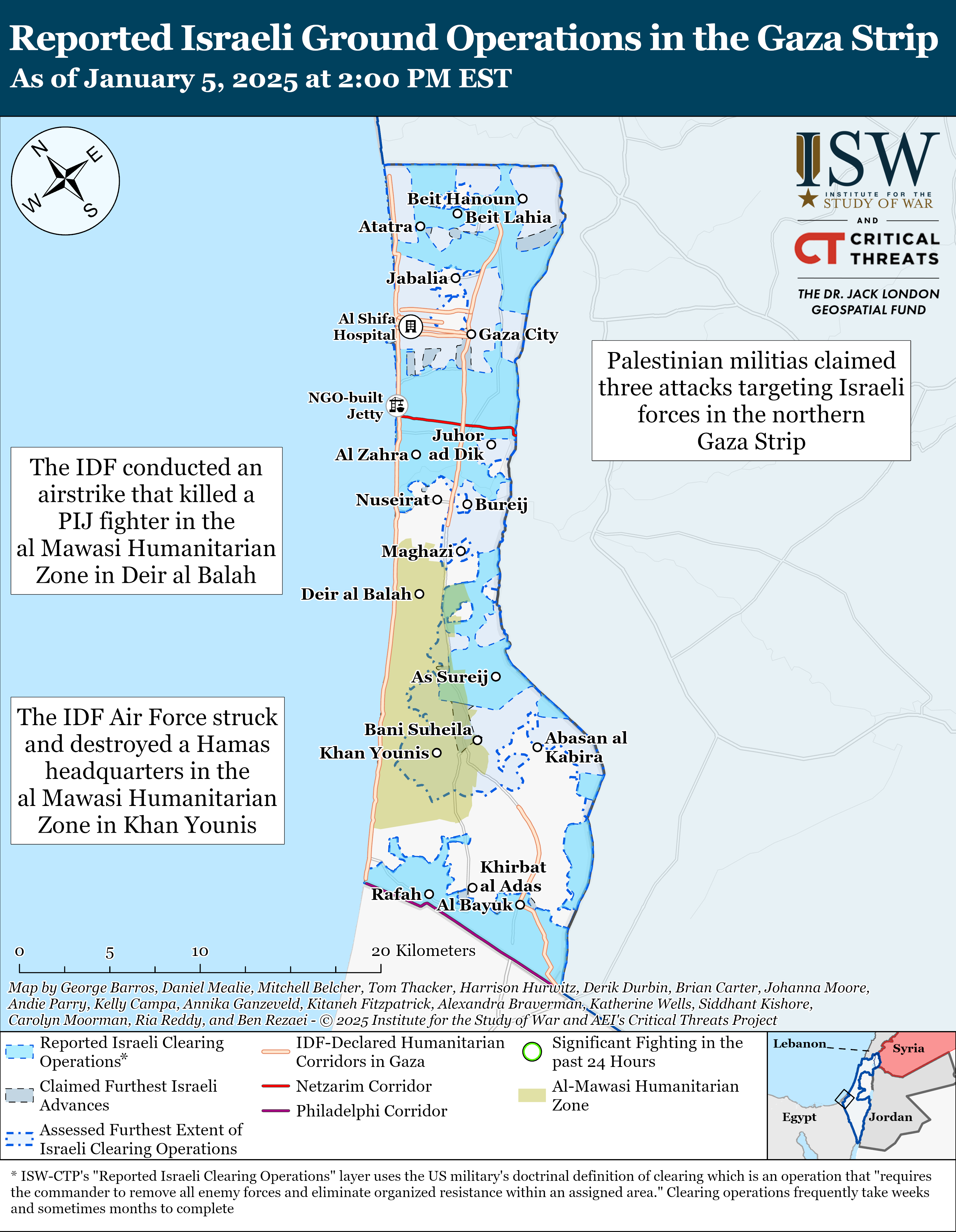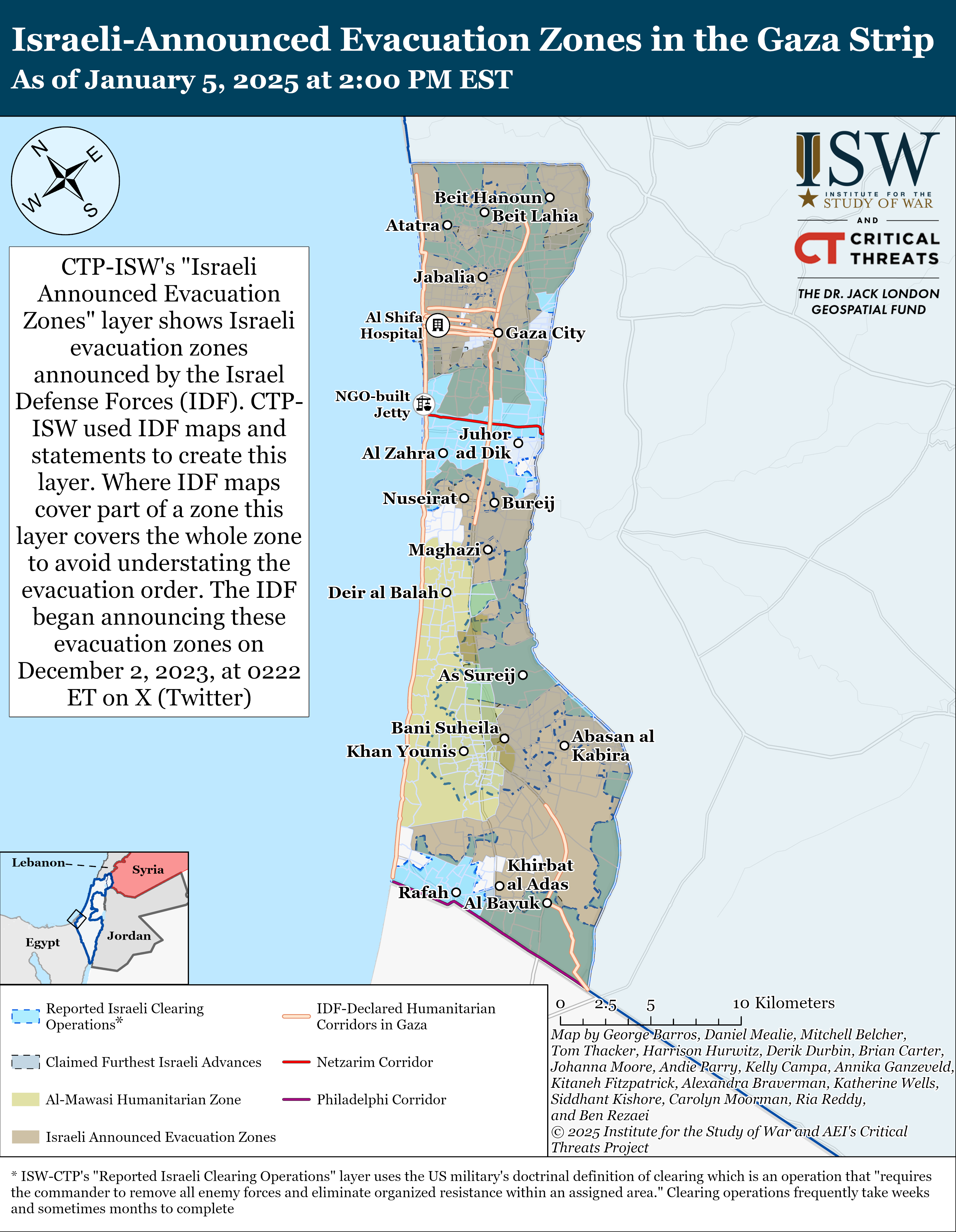Katherine Wells, Alexandra Braverman, Siddhant Kishore, Kelly Campa and Brian Carter
Information Cutoff: 2:00 pm ET
The
Critical Threats Project (CTP) at the American Enterprise Institute and
the Institute for the Study of War (ISW) publish the Iran Update, which
provides insights into Iranian and Iranian-sponsored activities that
undermine regional stability and threaten US forces and interests.
Click here to see CTP and ISW’s interactive map of Israeli ground operations, and here
to see CTP and ISW’s interactive map of the ongoing opposition
offensive in Syria. These maps are updated daily alongside the static
maps present in this report.
We do not report in
detail on war crimes because these activities are well-covered in
Western media and do not directly affect the military operations we are
assessing and forecasting. We utterly condemn violations of the laws of
armed conflict and the Geneva Conventions and crimes against humanity
even though we do not describe them in these reports.
Iran is likely taking a series of steps to prevent instability in Iraq after the fall of the Assad Regime. Iranian
Islamic Revolutionary Guards Corps (IRGC) Quds Force Commander Esmail
Ghaani arrived in Baghdad on January 5 for covert meetings with senior
Iraqi officials and militia commanders to discuss “restructuring” an
informed source told Iraqi media.[1]
Ghaani will reportedly meet with the Iraqi prime minister, leaders in
the Popular Mobilization Forces (PMF), and the Iraqi “armed forces
commander.” Ghaani and the IRGC very likely also discuss the fall of the
Assad Regime with these key Iraqi leaders. The many militia elements
that withdrew from Syria will presumably also need to be reorganized.
IRGC Ground Forces Special Forces Brigade also recently conducted
military exercises in the western Kermanshah province and the Iranian
Artesh Ground Forces deployed several brigades in western Iran to
confront hostile groups aimed to create instability on Iran’s western
border with Iraq, illustrating Iran‘s preoccupation with the threat
posed by insecurity in Iraq.[2]
IRGC-affiliated
media separately published an op-ed that highlights some of the
probable concerns that Iran has after the fall of Syria. The op-ed
claimed that political insecurity in Syria could be transported to Iraq
by terrorists who assassinate key Iraqi officials to cause insecurity
and destabilize the country. [3]Tasnim‘s
Salman al Maliki claimed that other powers, such as the United States
and Israel, would try to exploit a power vacuum in Iraq for their own
interests. Iran regularly holds the United States and Israel responsible
for the formation of Islamic State in Iraq and Syria (ISIS) and could
conclude that ISIS attacks targeting Iraqi military officers and
officials are encouraged by the United States and Israel.[4]
Maliki could also be referring to retaliatory Israeli or US strikes
against militia targets in response to future attacks targeting Israel
or US bases. Maliki urged Iraq to create a joint political and military
council for addressing these security threats, sharing intelligence, and
responding to terrorism in the op-ed.[5]
Iranian media outlets continue to stoke sectarian conflict over the Shia Sayyida Zeinab Shrine in Damascus.
Tabnak reported on January 4 that an HTS-linked commander entered the
Sayyida Zeinab shrine in Damascus and repeated “sectarian and sarcastic
sentences.”[6]
Tabnak claimed that the provocative video could lead the Shiites and
Alawites in Syria to respond with “harsh actions.” Tabnak has previously
claimed that HTS fighters have threatened the security of the sacred
Shia shrine.[7]
Syrian
Popular Resistance, which is a purportedly Syrian telegram channel
espousing sectarian narratives, accused the HTS-led government of
killing six Sayyida Zeinab Shrine workers after six dead bodies were
reportedly found on January 5.[8]
The channel provided no evidence of the deaths or whether the killings
were motivated by sectarian violence. This is also the first time the
channel has discussed Sayyida Zeinab, which is notable given that most
of the claims about the shrine have come from the Iranian information
space.
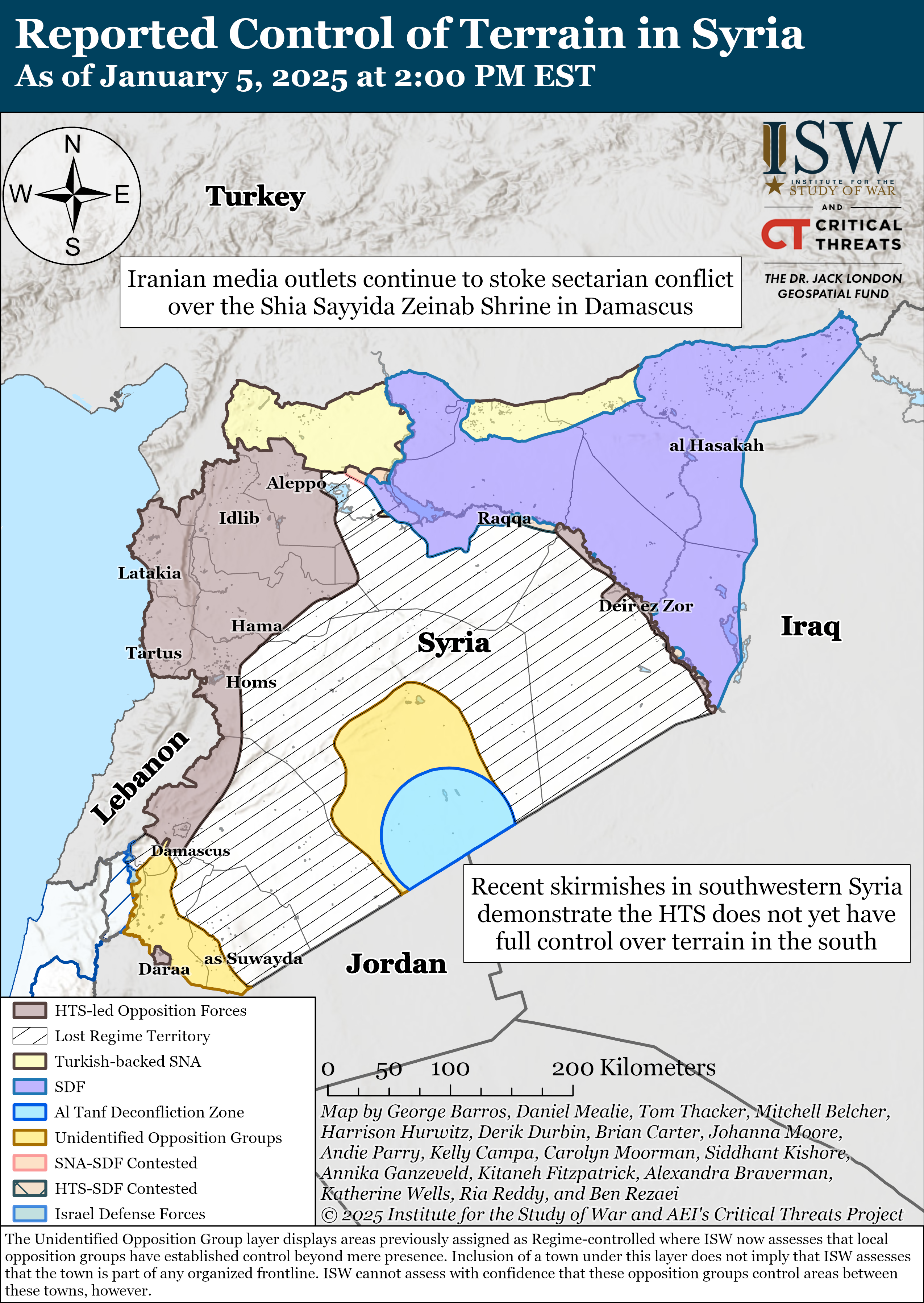
Senior
Israeli officials indicated on January 5 that the IDF will likely
extend its deployment in southern Lebanon if the Israel-Lebanon
ceasefire agreement conditions are not met by January 26. Israeli
Defense Minister Israel Katz stated that if the first condition of the
Israel-Lebanon ceasefire agreement–the complete withdrawal of Hezbollah
and dismantling of Hezbollah weapons and infrastructure by the Lebanese
Armed Forces (LAF)–is not met, Israel will be “forced to act on its
own.”[9]
Katz specified that if Hezbollah does not withdraw there is “no
agreement.” The outgoing IDF 91st Division Commander Brigadier General
Shai Klepper similarly stated in an interview published on January 5
that the IDF is ”not expected” to leave southern Lebanon after the
60-day ceasefire period concludes if the IDF’s objectives are not
fulfilled.[10]
The 91st Division is responsible for Israel’s northern border with
Lebanon. Israeli media reported that the United States and Israel are
making unspecified efforts to extend the 60-day ceasefire with Hezbollah
to prevent a ”premature withdrawal” or a return to full-scale war
between Israel and Hezbollah.[11]
The
LAF likely does not have the organizational capability or willingness
to meet the conditions of the ceasefire by January 26. Israeli
media reported the IDF still controls most of the Lebanese territory as
it did in November 2024, when the ceasefire deal was signed.[12] The Washington Post
similarly reported that the IDF has withdrawn and allowed the LAF to
backfill in only two of the over 60 IDF-controlled areas in southern
Lebanon.[13]
Israeli Defense Minister Israel Katz stated that Hezbollah fighters and
weapons have not yet moved north of the Litani River, as required by
the deal.[14]
CTP-ISW has previously noted that it is extremely unlikely that the LAF
or UNIFIL would be willing to enforce Hezbollah’s disarmament in the
south, given their failure to enforce UNSCR 1701 in southern Lebanon
since 2006.[15]
Recent skirmishes in southwestern Syria demonstrate the HTS does not yet have full control over terrain in the south. A
reportedly former regime-affiliated militia led by Mohsen al Haymad
engaged other local factions with rocket-propelled grenades (RPG) and
small arms in al Sanamayn City, northern Daraa Province, on January 4.[16]
Syrian sources suggested that Haymad‘s faction clashed with local
groups affiliated with the Southern Operations Room, but it is not clear
what started the fighting.[17] Haymad’s faction has operated in al Sanamayn since at least 2018 when the group reconciled with the Assad regime and began collaborating with regime Military Intelligence, according to Syrian opposition media.[18]
Many Southern Operations Room commanders—including Ahmed al Awda, a key
commander in the group—were also former opposition groups that
reconciled with the regime in 2018 under a Russian reconciliation plan.[19]
The HTS-led Department of Military Operations deployed reinforcements
to al Sanamayn City and convened the factions to negotiate a ceasefire.[20] Haymad’s group and other unspecified local factions agreed to a ceasefire and to hand over heavy weapons to HTS forces.[21]
HTS reportedly allowed the local groups to retain their individual
weapons, however, which contradicts HTS’s policy of requiring the
disarmament of all armed groups within Syria.[22]
Short-term arrangements to ensure temporary security in al Sanamyan may
present problems in the future as HTS continues its mission to disarm
and dissolve armed factions into the Syrian Defense Ministry. This
incident also highlights that the Southern Operation Room has not yet
been fully folded into HTS’s forces. HTS-controlled forces will remain
in al Sanamayn to set up checkpoints and maintain security within the
city.[23]
The necessity of HTS forces and checkpoints in the city underscores
HTS’s lack of control over armed factions in the Daraa and other
southern provinces, which regularly sees fighting between local groups.
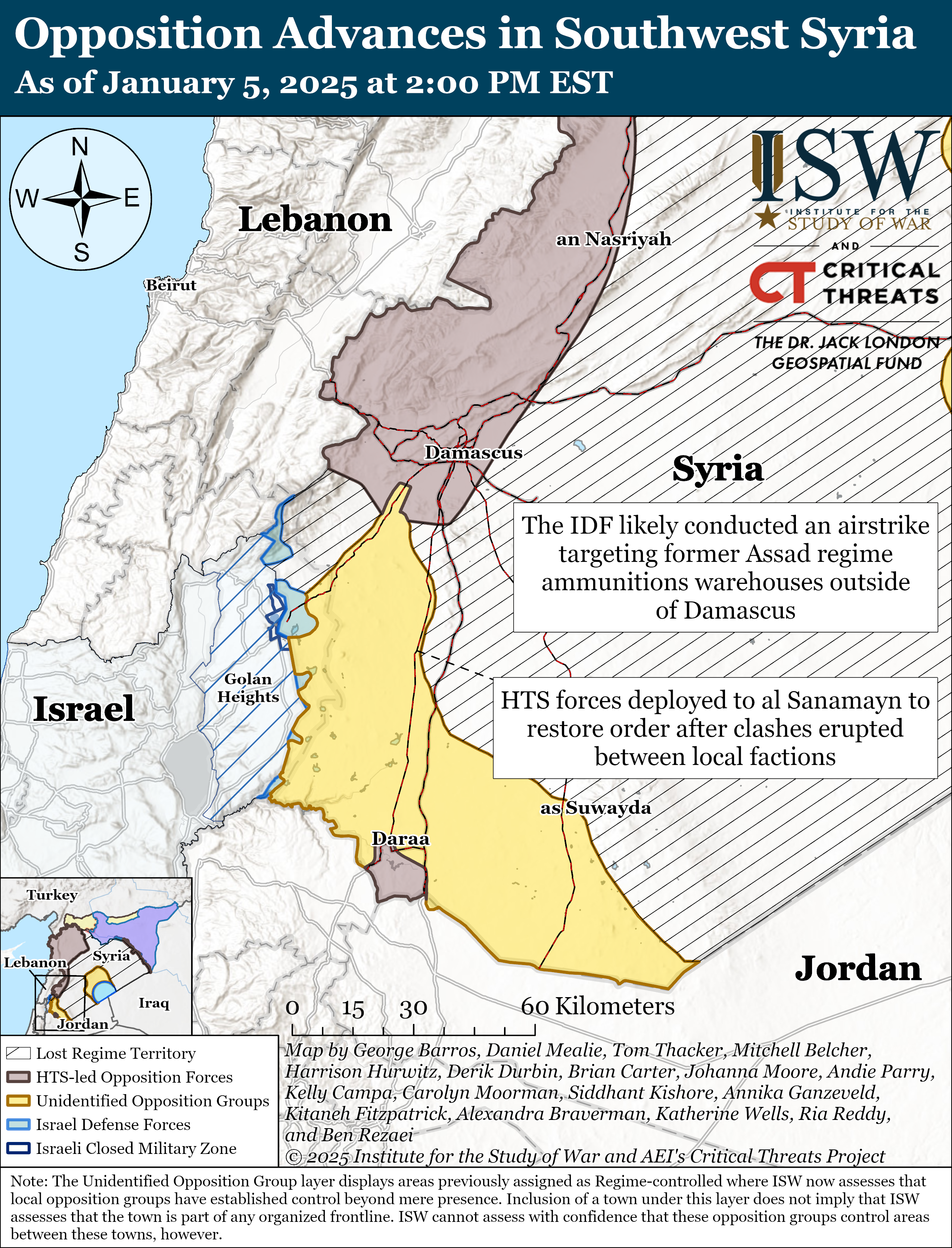
Key Takeaways:
- Iranian Regional Policy: Iran
is taking a series of steps to prevent instability in Iraq after the
fall of the Assad Regime. Iranian Islamic Revolutionary Guards Corps
(IRGC) Quds Force Commander Esmail Ghaani arrived in Baghdad on January
5.
- Iranian Information Space: Iranian media outlets continue to stoke sectarian conflict over the Shia Sayyida Zeinab Shrine in Damascus.
- Lebanon: Senior
Israeli officials indicated on January 5 that the IDF will likely
extend its deployment in southern Lebanon if the Israel-Lebanon
ceasefire agreement conditions are not met by January 26. The Lebanese
Armed Forces likely do not have the organizational capability or
willingness to meet the conditions of the ceasefire by January 26.
- Southwestern Syria: Recent skirmishes in southwestern Syria demonstrate the HTS does not yet have full control over terrain in the south.
Syria
Axis of Resistance objectives:
The
Turkish-backed Syrian National Army (SNA) outflanked the southern
advance of the US-backed Syrian Democratic Forces (SDF) along the
Aleppo-Raqqa highway. Several anti-SDF media outlets and users
reported that the SNA seized control of several villages in the desert
south of Maskanah and advanced up to the train tracks south of the city.[24]
This would place SNA forces within about five kilometers of Maskanah.
Anti-SDF media posted a photo of SNA fighters observing Maskanah from a
position in the desert.[25]
Maskanah sits along the Aleppo-Raqqa highway and its capture would cut
off the westernmost SDF advances along the Aleppo-Raqqa highway from
Raqqa and Tabqa cities to the east. The SDF previously seized Maskanah
during its southern advance towards Deir Hafer and Khafseh between
December 23 and 24.[26] An anti-SDF social media user claimed that the SDF remains in Deir Hafer as of January 5.[27] Anti-SDF media reported that the SDF prepared defenses in Maskanah on January 5 ahead of a potential SNA assault on the city.[28]
The
SNA’s advance threatens the SDF’s control of the Aleppo-Raqqa highway
and its ability to provide reinforcements and logistical support to SDF
fighters deployed in Deir Hafer and along the Khafseh axis. A potential
SNA capture of Maskanah would make the SDF counteroffensive much more
difficult, if not impossible. Capturing Maskanah would also threaten SDF
strongholds Tabqa and Raqqa, located further east along the
Aleppo-Raqqa highway. Threats to Tabqa and Raqqa would force the SDF to
decide between prioritizing the Euphrates River crossings or Raqqa City.
The
SNA and Turkey continued to pressure the SDF's ability to sustain
operations west of Tishreen Dam through air and artillery on January 5.[29] The
SDF said it continued to repel SNA attacks supported by Turkish air
support in the Manbij countryside and near the Tishreen Dam on January
4.[30]
Local media reported that Turkey conducted several airstrikes targeting
SDF positions near the Dam and along supply lines from Raqqa to the
frontlines, including on SDF logistics in al Jarniya District and an SDF
position near Sarrin.[31] The SNA also reportedly shelled the entrances to Tishreen Dam and an SDF position in Ain Issa.[32] The SDF announced the death of 12 of its fighters on January 5.[33]
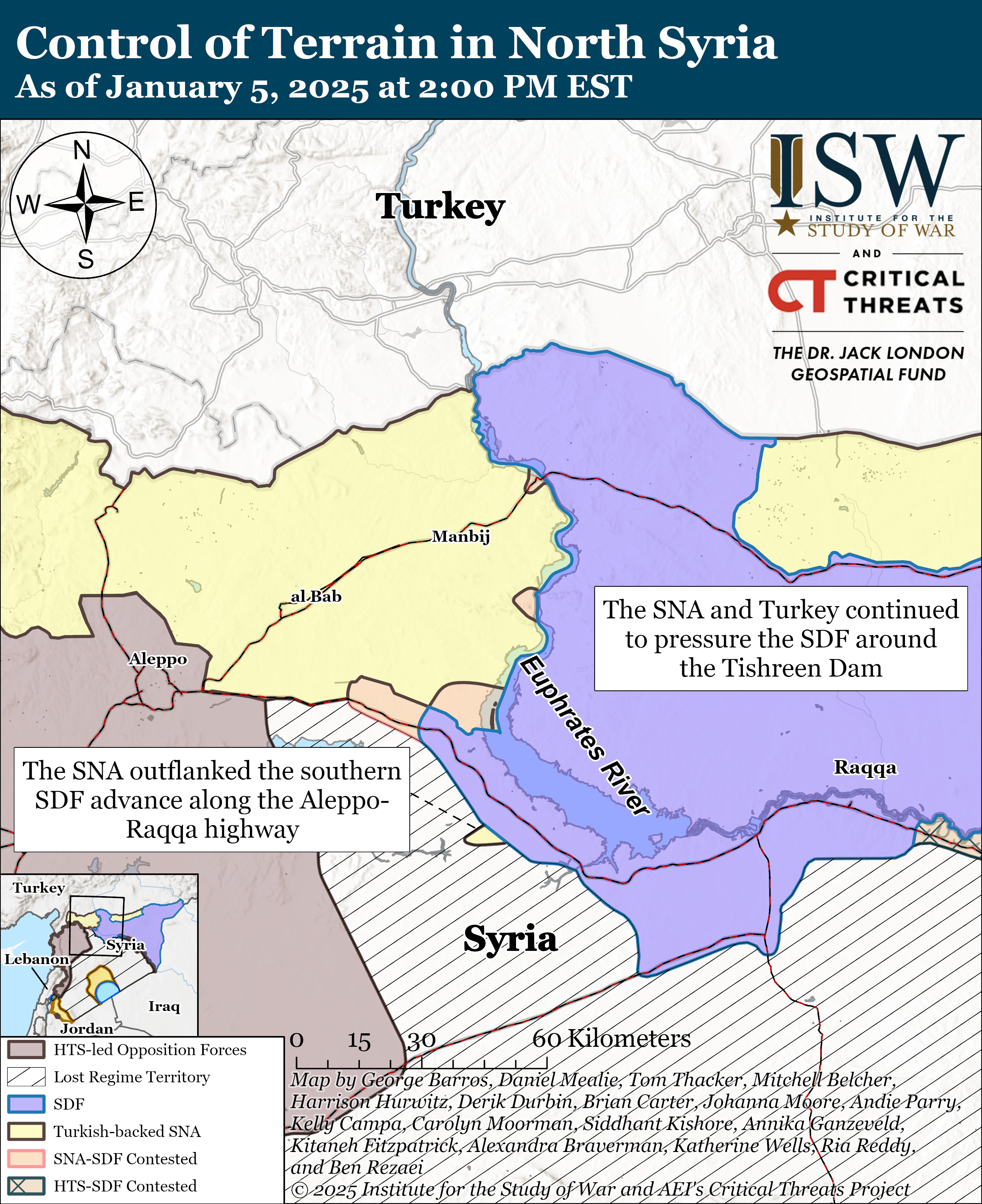
Syrian interim government officials traveled to Doha, Qatar, on January 5 in Doha, Qatar, on January 5.[34]
Syrian Interim Foreign Affairs Minister Asad al Shaibani, Interim
Defense Minister Marhaf Abu Qasra, and Interim Intelligence head Anas
Khattab met with Qatari Prime Minister and Foreign Minister Mohammad al
Thani and Qatari Minister of State Mohammed bin Abdulaziz al Khulaifi.[35] Shaibani thanked al Thani for providing humanitarian aid to Syria.[36] Shaibani said that the delegation discussed “all basic and strategic issues” with al Thani.[37]
Shaibani and interim head of government Ahmed al Shara previously met
with Khulaifi to discuss Syria’s impending “broad strategic cooperation”
with Qatar, particularly in the energy sector and in rebuilding Syrian
ports in Damascus on December 23.[38]
Qatar, which never normalized relations with the Assad regime, was
among the first states to open contact with HTS after the fall of Assad.
The
Israel Defense Forces (IDF) reported on January 5 that the IDF 810th
Mountain Brigade (210th Division) completed a brigade-level operation in
the Syrian Mt. Hermon area in recent weeks.[39] The IDF seized the Syrian side of Mt. Hermon on December 8 following the fall of the Assad regime.[40] The 810th Brigade raided ”control points” and searched military buildings in the Mt. Hermon area.[41] The brigade destroyed intelligence equipment and weapons including anti-tank missiles, rockets, launchers, and IEDs.
The IDF likely conducted an airstrike targeting former Assad regime ammunition warehouses near Damascus on January 5. Syrian
media posted footage purportedly showing explosions in former Syrian
Arab Army (SAA) 58th Brigade weapons warehouses that contained rockets
and other unspecified ammunition in Sahia village, Rif Dimashq Province.[42]
A separate Syrian outlet posted footage to X (Twitter) showing
explosions in a weapons storage facility for an SAA air defense
battalion near al Kiswah, south of Damascus.[43]
Iraq
Axis of Resistance objectives:
Nothing significant to report.
Arabian Peninsula
Axis of Resistance objectives:
The Houthis launched a ballistic missile attack targeting the Orot Rabin power station in Hadera, central Israel on January 5. xlvi The IDF intercepted the missile before it entered Israeli territory on January 4. xlvii
Houthi
media reported that the United States and United Kingdom conducted
three airstrikes east of Saada City, northern Yemen, on January 4. xlviii
The Palestinian Territories and Lebanon
Axis of Resistance objectives:
The Gaza Strip
The IDF 900th Infantry Brigade (99th Division) concluded its deployment in the northern Gaza Strip on January 5.[44]
The 900th Infantry Brigade conducted clearing operations in Beit
Hanoun, Beit Lahia, and Jabalia refugee camps during its two-month-long
deployment in the northern Gaza Strip. Palestinian militias killed 13
Israeli soldiers from the 900th Infantry Brigade during this time,
according to an Israeli Army Radio correspondent.[45] There are three IDF maneuver brigades active in the Gaza Strip.
The IDF 84th Infantry Brigade (162nd Division) killed a PIJ rocket unit commander in the northern Gaza Strip last week.[46] Footage posted by the IDF showed the PIJ commander and his subordinate attempting to approach the Israeli forces.[47] The IDF encircled them, killed the commander, and detained his subordinate.[48] The IDF
said that the PIJ commander participated in the October 7 attacks and
conducted attacks targeting Israeli forces conducting operations in Beit
Lahia.
Palestinian militias claimed three attacks targeting Israeli forces in the northern Gaza Strip on January 5.[49] Hamas
and Palestinian Islamic Jihad (PIJ) claimed that they fired small arms
and three hand grenades at IDF infantry in western Beit Lahia.[50]
PIJ and the Palestinian Mujahideen Movement claimed two attacks
targeting the IDF in the Jabalia refugee camp in the northern Gaza
Strip.[51]
The IDF stated that Palestinian militia gunfire seriously injured an
IDF soldier from the 84th Infantry Brigade in the northern Gaza Strip on
January 5.[52]
The
IDF conducted airstrikes targeting Palestinian militia infrastructure
and fighters in the central and southern Gaza Strip on January 5.[53]
The IDF conducted an airstrike that killed a PIJ fighter in the al
Mawasi Humanitarian Zone in Deir al Balah, central Gaza Strip. [54]
The IDF Air Force separately struck and destroyed a Hamas headquarters
in the al Mawasi Humanitarian Zone in Khan Younis, southern Gaza Strip.[55] The IDF Air Force struck more than 100 Palestinian militia targets across the Gaza Strip on January 3 and 4.[56]
The IDF stated that it took steps to reduce the risk of civilian
casualties by using precision munitions and analyzing aerial imagery
before these airstrikes.[57]
Lebanon
Senior
Hezbollah official Wafiq Safa told reporters on January 5 that former
Hezbollah Secretary General Hassan Nasrallah will be buried on January
25, which is the 60th day of the Israel-Lebanon ceasefire agreement, in
the southern suburbs of Beirut, Lebanon.[58] Israel killed Nasrallah in an airstrike on September 27, 2024.
Israeli
and Lebanese media reported on January 4 that the IDF conducted a
controlled demolition of infrastructure in Taybeh, southeastern Lebanon,
and Tyre Harfa, southwestern Lebanon.[59] An
Israeli Army Radio correspondent noted that both these Lebanese towns
are located in the ”second line” of Lebanese towns, located several
kilometers from the Israel-Lebanon border.[60]
The ”second line“ of towns refers to towns located approximately 6-8
kilometers north of the Israel-Lebanon border which falls within the
range that Hezbollah could use to launch drones and rockets at Israel.[61]
The Israeli Army Radio correspondent noted that it is noteworthy that
the IDF is still operating in this ”second line” of towns and has not
yet withdrawn to the first line which could indicate that the IDF does
not intend to withdraw at the end of the month. The IDF would be
required to withdraw if Hezbollah and the Lebanese Armed Forces (LAF)
uphold their end of the Israel-Lebanon ceasefire agreement.
Lebanese media separately reported on January 4 that the IDF fired artillery in Kfarchouba, southeastern Lebanon.[62] Lebanese media reported that an IDF mechanized infantry unit operated on the outskirts of Kfarchouba, on January 4.[63]
Lebanon Artillery map
West Bank
The
IDF conducted raids in the town of Meithalun in Jenin Governorate,
northern West Bank, and killed a local al Aqsa Martyrs’ Brigades
commander on January 5.[64]
The IDF also confiscated weapons, destroyed an IED manufacturing
facility, and seized tens of thousands of Israeli shekels in “terrorist
funds” during the raids.[65] PIJ fired small arms targeting Israeli forces conducting raids in Meithalun.[66]
Iranian Decision-Making, Internal Dynamics, and Foreign Policy
Nothing significant to report.
The
Iran Update provides insights into Iranian and Iranian-sponsored
activities abroad that undermine regional stability and threaten US
forces and interests. It also covers events and trends that affect the
stability and decision-making of the Iranian regime. The Critical
Threats Project (CTP) at the American Enterprise Institute and the
Institute for the Study of War (ISW) provides these updates regularly
based on regional events.
CTP-ISW defines the
“Axis of Resistance” as the unconventional alliance that Iran has
cultivated in the Middle East since the Islamic Republic came to power
in 1979. This transnational coalition is comprised of state, semi-state,
and non-state actors that cooperate to secure their collective
interests. Tehran considers itself to be both part of the alliance and
its leader. Iran furnishes these groups with varying levels of
financial, military, and political support in exchange for some degree
of influence or control over their actions. Some are traditional proxies
that are highly responsive to Iranian direction, while others are
partners over which Iran exerts more limited influence. Members of the
Axis of Resistance are united by their grand strategic objectives, which
include eroding and eventually expelling American influence from the
Middle East, destroying the Israeli state, or both. Pursuing these
objectives and supporting the Axis of Resistance to those ends have
become cornerstones of Iranian regional strategy.

[1]
https://shafaq dot
com/ar/%D8%B3%DB%8C%D8%A7%D8%B3%D8%A9/%D8%A8%D8%B2%D9%8A%D8%A7%D8%B1%D8%A9-%D8%B3%D8%B1%D9%8A%D8%A9-%D9%82%D8%A7-%D9%86%D9%8A-%D9%81%D9%8A-%D8%A8%D8%BA%D8%AF%D8%A7%D8%AF-%D8%AD%D8%A7%D9%85%D9%84%D8%A7-%D8%B9%D8%AF%D8%A9-%D9%85%D9%84%D9%81%D8%A7%D8%AA-%D8%A8%D9%8A%D9%86%D9%87%D8%A7-%D9%87%D9%8A%D9%83%D9%84%D8%A9-%D8%A8%D8%B9%D8%B6-%D8%A7%D9%84%D9%81%D8%B5%D8%A7-%D9%84-%D8%A7%D9%84%D9%85%D8%B3%D9%84%D8%AD%D8%A9
[2] https://www.understandingwar.org/backgrounder/iran-update-january-4-2025
[3] https://www.tasnimnews dot com/fa/news/1403/10/16/3232253
[4] https://time.com/3720081/isis-iran-us-creation/
[5] https://www.tasnimnews dot com/fa/news/1403/10/16/3232253
[6] https://www.tabnak dot ir/fa/news/1281599 ; https://vista dot ir/n/arshehonline-151y7
[7] https://www.iswresearch.org/2024/12/iran-update-december-16-2024.html
[8] https://t.me/syria_mukawama/5119 ;
https://www.understandingwar.org/backgrounder/iran-update-december-31-2024
[9] https://news.walla dot co.il/item/3716991 ; https://www.timesofisrael dot com/full-text-the-israel-hezbollah-ceasefire-deal/
[10] https://x.com/Doron_Kadosh/status/1875829513868734835
[11] https://www.jpost dot com/middle-east/article-836212
[12] https://news.walla dot co.il/item/3716991
[13] https://wapo.st/3DJkQQL
[14]
https://www.washingtonpost.com/world/2025/01/05/israel-war-news-lebanon-syria-hamas-gaza-palestine/?pwapi_token=eyJ0eXAiOiJKV1QiLCJhbGciOiJIUzI1NiJ9.eyJyZWFzb24iOiJnaWZ0IiwibmJmIjoxNzM2MDUzMjAwLCJpc3MiOiJzdWJzY3JpcHRpb25zIiwiZXhwIjoxNzM3NDM1NTk5LCJpYXQiOjE3MzYwNTMyMDAsImp0aSI6IjQ5YzJiMGVkLTg5NDQtNDhiNS1iMDFmLThjYmRmZTk0MTBhZSIsInVybCI6Imh0dHBzOi8vd3d3Lndhc2hpbmd0b25wb3N0LmNvbS93b3JsZC8yMDI1LzAxLzA1L2lzcmFlbC13YXItbmV3cy1sZWJhbm9uLXN5cmlhLWhhbWFzLWdhemEtcGFsZXN0aW5lLyJ9._ifnHTNippywyH_okdb-DZHldGfHri_gW1V-Gi7QcUA
[15] https://www.understandingwar.org/backgrounder/iran-update-november-19-2024
[16] www dot npasyria.com/en/120576
[17] https://x.com/Omar_Madaniah/status/1875556225389379806; www dot npasyria.com/en/120576
[18] www dot npasyria.com/en/120576
[19] https://www.elwatannews dot com/news/details/7725423
[20] https://x.com/Daraa24_24/status/1875871306991951937; https://x.com/abdulrahmanpho/status/1875864787839791475; https://x.com/NPA_Arabic/status/1875812942232613362; https://x.com/omar_alharir/status/1875830520699142411
[21] https://x.com/Daraa24_24/status/1875871306991951937
[22] https://x.com/Daraa24_24/status/1875871306991951937
[23] https://x.com/Daraa24_24/status/1875871306991951937; www dot npasyria.com/en/120620
[24] https://x.com/DeirEzzore/status/1875967939481833898; https://t.me/AbomosaabSharkea/132011; https://t.me/AbomosaabSharkea/132026; https://x.com/nahermedia/status/1875993213502427161
[25] https://t.me/AbomosaabSharkea/132059
[26] https://www.understandingwar.org/backgrounder/iran-update-december-26-2024
[27] https://x.com/DeirEzzore/status/1875967939481833898
[28] https://t.me/AbomosaabSharkea/132026 ;
https://x.com/DeirEzzore/status/1875967939481833898; https://x.com/HalabTodayTV/status/1875777871316131887; https://x.com/nahermedia/status/1875861385839874065
[29] https://x.com/DeirEzzore/status/1875967939481833898
[30] https://x.com/SiyamandAli/status/1875587747299406199
[31] https://x.com/nahermedia/status/1875968645677093216; https://t.me/AbomosaabSharkea/132074; https://x.com/nahermedia/status/1875872085677113827; https://x.com/DeirEzzore/status/1875967939481833898
[32] https://x.com/DeirEzzore/status/1875967939481833898; https://x.com/SOHEB2019/status/1875942916482638155
[33] https://x.com/SiyamandAli/status/1875933261131870329
[34] https://t.me/syrianmofaex1/74
[35] https://t.me/syrianmofaex1/85
[36] https://t.me/syrianmofaex1/85
[37] https://x.com/thiqanewsagency/status/1875876903099486708
[38] https://www.understandingwar.org/backgrounder/iran-update-december-23-2024 ; https://x.com/syrianmofaex/status/1871167063986675897
[39] https://www dot idf.il/262668
[40] https://www.jpost dot com/middle-east/article-832540
[41] https://www dot idf.il/262668
[42] https://t.me/damascusv011/27367 ; www dot npasyria.com/202154
[43] https://x.com/HalabTodayTV/status/1875900027958386827
[44] https://t.me/moriahdoron/18008
[45] https://t.me/moriahdoron/18008
[46] https://www.idf dot il/262841
[47] https://t.me/moriahdoron/18029 ; https://www.idf dot il/262841
[48] https://www.idf dot il/262841
[49] https://t.me/sarayaps/19026 ; https://t.me/darebmojahden/5451 ; https://t.me/sarayaps/19027
[50] https://t.me/sarayaps/19027
[51] https://t.me/sarayaps/19026 ; https://t.me/darebmojahden/5451
[52] https://x.com/GLZRadio/status/1875941286752202913 ; https://x.com/idfonline/status/1875940902004498740
[53] https://x.com/idfonline/status/1875955985548009535 ; https://x.com/idfonline/status/1875955988601397462
[54] https://x.com/idfonline/status/1875955988601397462
[55] https://x.com/idfonline/status/1875955985548009535
[56] https://x.com/idfonline/status/1875770693276823763
[57] https://x.com/idfonline/status/1875770696691019793 ; https://x.com/idfonline/status/1875955988601397462
[58] https://t.me/channelnabatieh/110659 ; https://www.timesofisrael dot com/liveblog_entry/nasrallah-to-be-buried-after-end-of-initial-60-day-ceasefire/
[59] https://t.me/moriahdoron/18014 ; https://t.me/bintjbeilnews/126428
; https://t.me/alichoeib1970/12940
[60] https://t.me/moriahdoron/18014
[61] https://www.timesofisrael dot com/aiming-to-enable-return-of-displaced-israelis-idf-pushes-deeper-into-south-lebanon/
[62] https://t.me/channelnabatieh/110650
[63] https://t.me/bintjbeilnews/126342
[64] https://x.com/idfonline/status/1875858455162245597 ; https://t.me/elaqsa_1965/8122
[65] https://x.com/idfonline/status/1875858455162245597
[66] https://t.me/sarayajneen/1954




